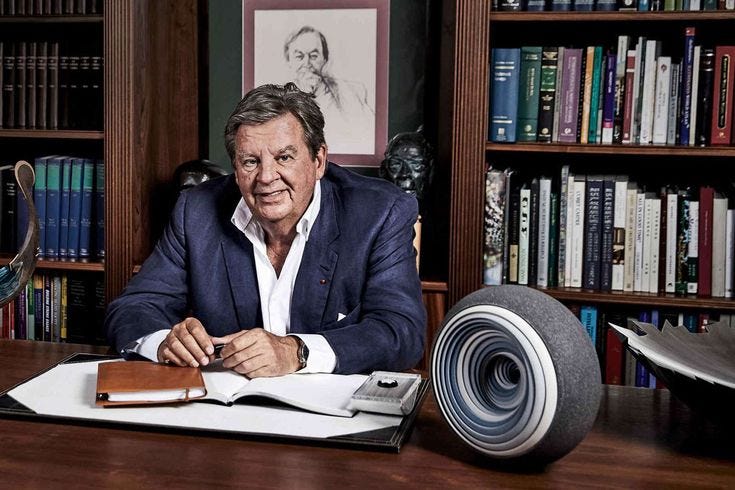The Rupert Family
From a humble tobacco company to the world’s second-largest luxury group, the Ruperts have become South Africa’s richest family. But how did they get there?
Born on October 4, 1916, in Graaff-Reinet, Anton Rupert laid the foundation for South Africa’s wealthiest family, led by his son Johann, with a net worth
of $14 billion in 2025 (Forbes). Aspiring to study medicine at the University of Pretoria, financial shortcomings led him to pursue a master’s in chemistry.
In 1941, Anton founded Voorbrand Tabakmaatskappy with a modest investment of 10 pounds, leveraging his insight that tobacco and alcohol sales remained stable during economic downturns. He faced fierce competition from United Tobacco, which held over 90% of the market.
From the outset, Anton embraced diversification. In the early 1940s, he established Tegniese en Industriele Beleggings (TIB), an investment company aimed at raising capital for Voorbrand and serving as a vehicle for entry into other sectors, notably liquor. Securing a license, he acquired distressed assets, including the Cape-based Forrer Brothers and equipment from a bankrupt Stellenbosch company. Partnering with Dirk Hertzog, he founded the Distillers Corporation—the first Afrikaans company listed on the Johannesburg Stock Exchange.
In 1945, a London trip introduced Anton to Sidney Rothman, head of Rothmans. With loans from Volkskas and Sanlam, Rembrandt later acquired a significant stake in Rothmans, securing a global presence. In 1948, Voorbrand was incorporated into Rembrandt Tabakvervaardigings Korporasie, named after the famous Dutch Baroque painter.
Anton’s diversification extended to luxury goods, acquiring a controlling stake in Cartier, the “jeweller of kings and king of jewellers.” In 1988, he consolidated his international tobacco and luxury assets under Compagnie Financière Richemont SA. Richemont has become the world’s second-largest luxury group after LVMH.
It was in the 1980s that his son arrived on the scene, and so we turn the chapter...
Johann Rupert: Expanding the Legacy
Born on June 1, 1950, in Stellenbosch, Johann Rupert attended Paul Roos Gymnasium and studied commerce and law at Stellenbosch University, but left to pursue business opportunities. Despite his father’s prominence, Johann sought independence, inspired by a Zulu proverb he learned from a political science lecturer: “Nothing grows beneath a big tree.”
He moved to New York, working 14-hour days at Chase Manhattan Bank for two years and Lazard Frères for three. He later remarked, “To my surprise, I found I enjoyed it.” Returning to South Africa in 1979, Johann founded Rand Merchant Bank (RMB), securing a valuable banking license. He soon merged RMB with university friends GT Ferreira, Paul Harris, and Laurie Dippenaar’s Rand Consolidated Investments (RCI), forming the foundation of what would become FirstRand.
Initially reluctant to join Rembrandt, Johann was drawn in 1984 after Sir Robert Crichton-Brown, Rothmans’ chairman, disrespected Anton by relegating him from a managerial to a shareholder only role. Johann joined Rembrandt as executive director and later orchestrated Crichton-Brown’s removal.
Johann played a central role in restructuring Rembrandt’s international operations. He oversaw the transfer of global assets to Compagnie Financière Richemont SA, a newly established group focused on international luxury interests.
In 1992, Johann became the non-executive chairman of Rembrandt. Being a citizen of the world with an extensive network, he proved invaluable. Under his leadership, Rembrandt was split into two: Remgro, holding tobacco, financial services, mining, and industrial interests; and Venfin, focused on technology and telecommunications. In 2009, the two were merged again, broadening Remgro’s portfolio to include media and tech.
Johann anticipated the disruptive potential of digital technology, especially among younger consumers. This foresight drove Richemont’s full acquisition of online luxury retailer Yoox Net-a-Porter in a $2.69 billion deal. In a strategic move to keep LVMH out of the space, Richemont struck a deal allowing LVMH brands to be sold on YNAP in exchange for an equity stake. A joint venture was also established with Alibaba to expand into the Chinese market.
Johann also steered clear of the Steinhoff scandal through three key incidents.
First, Steinhoff CEO Markus Jooste bought Anton’s Hermanus house and cut down five Norfolk pines (landmarks for local fishermen) prompting Johann to remark, “Civilised people plant trees; they don’t chop them down.”
Second, Johann was alerted by his wife, a racehorse breeder, to look into the financials of Cape Thoroughbred Sales, where Jooste was a director. Disturbed by the statements, Rupert requested an independent review by PwC.
Finally, at Florida’s Seminole Golf Club, an investor criticized Steinhoff’s Mattress Firm purchase as wildly overvalued, asking who the “damn morons” were behind the deal. When Steinhoff collapsed in 2017, Rupert’s caution was vindicated. Three strikes and Jooste was out.





